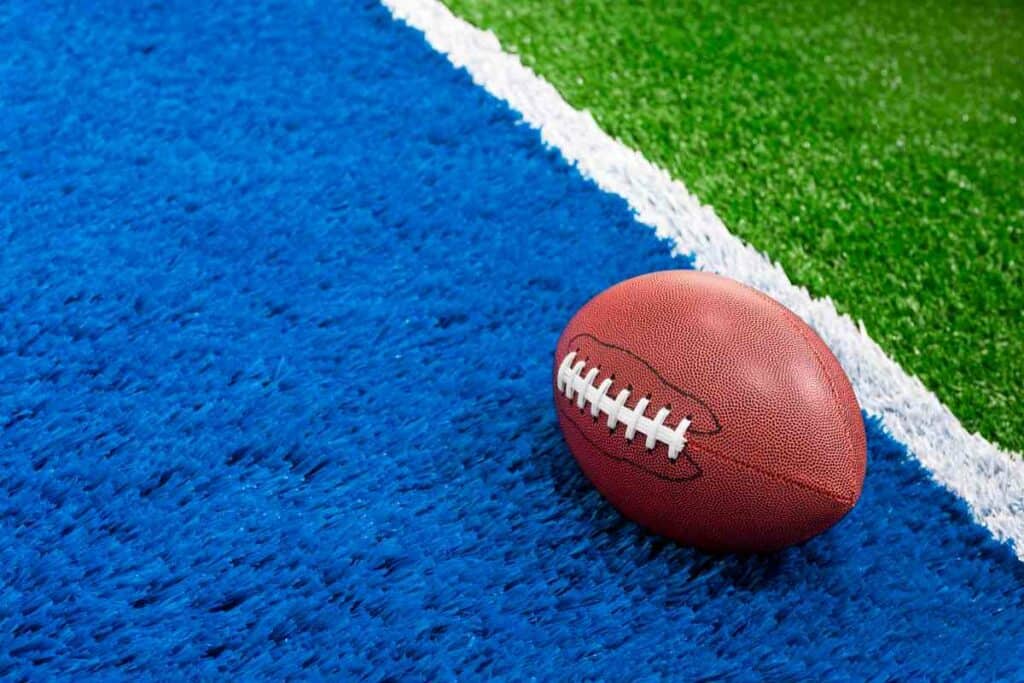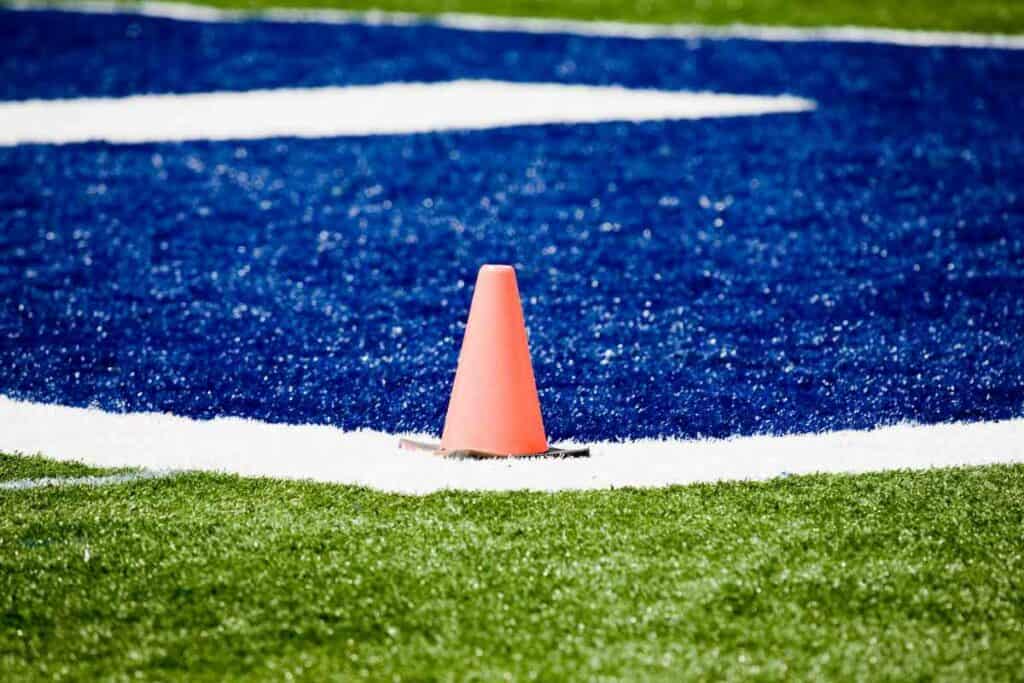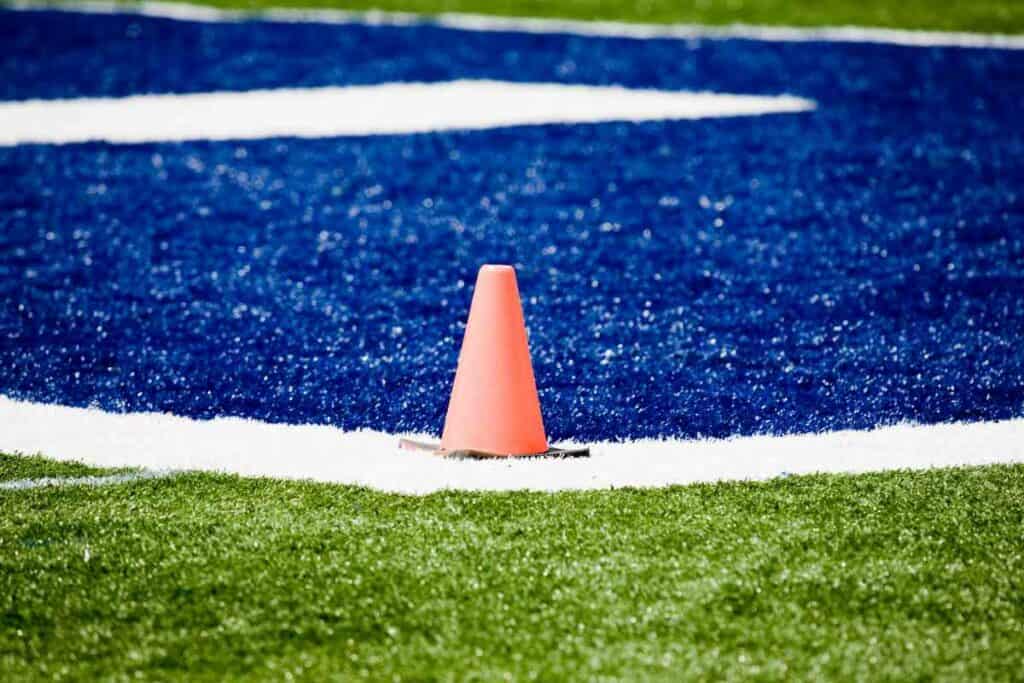What’s a Touchback In Football? Understanding the Rule and Its Impact on the Game
In football, a touchback occurs when the ball is declared dead after being downed or going out of bounds behind the defending team’s goal line following a kickoff or punt. After a kickoff touchback, the ball is placed on the receiving team’s 25-yard line, while a punt touchback places the ball on the 20-yard line. The defending team then takes possession at these spots, starting a new series of downs.

Related Post! What’s A Fumble In Football?
What’s a touchback in football?
A touchback in football occurs when the ball is downed or goes out of bounds in the end zone following a kickoff or punt, without being returned by the receiving team. It results in the receiving team starting their offensive drive from their own 25-yard line in the NFL and college football, aiming to enhance player safety by reducing high-speed collisions and potential injuries.
The rules around touchbacks aim to reduce unnecessary risks, such as attempting to run the ball out of the end zone, which could lead to tackles and injuries. This is why recent rule changes have been adapted to encourage touchbacks, impacting both player safety and game strategy.
Key Takeaways
- A touchback in football transfers possession to the defending team after the ball is dead in their end zone.
- The placement of the ball after a touchback varies between kickoffs and punts.
- Touchback rules are designed to discourage risky plays, enhancing player safety and influencing game strategy.
Basic Definitions
Understanding Touchback
A touchback is a play that results when the ball is downed in the end zone following a kick, without being advanced by the receiving team. This can happen when a punt or kickoff lands in the end zone or is carried there but not returned out. For example, a player taking a knee in the end zone during a kickoff indicates a touchback, and the ball is then placed on the 25-yard line for the next drive.
Kickoff and Punt Mechanics
- Kickoffs: A touchback is signaled if the ball flies out of the end zone or is downed inside it, such as when the kick returner decides not to take the ball out.
- Punts: A punt resulting in the ball landing in the end zone or being downed by the kicking team there also leads to a touchback.
Key roles in these scenarios include:
- Kicking Team: Aims to space the field to their advantage through the kick or punt.
- Receiving Team: Decides whether to return the kick or allow a touchback.
The return specialists on the receiving team play a crucial role in determining the kick’s outcome, significantly affecting their team’s starting field position. The kicking team’s goal is to avoid a touchback and pin the receiving team as close to their own end zone as possible.
Related Post! Here’s How High School Football Overtime Works!
Rules and Regulations
Understanding the concept of a touchback in football is crucial, as it significantly impacts possession and field positioning, key elements of strategic gameplay.

When Is a Touchback Called
In both NFL and NCAA football, a touchback is called when:
- The ball is kicked into the end zone and stops without being touched.
- A player downs the ball in their own end zone after catching a kickoff or punt.
- The ball goes out of bounds in the end zone without being touched, except for a kickoff going out of the back of the end zone.
- A player takes a knee in the end zone after catching the ball.
Consequences of a Touchback
After a touchback:
- The receiving team gains possession of the ball.
- The offensive team starts their drive at their own 25-yard line in college football, or at the 20-yard line in the NFL.
- This rule aims to prevent teams from being disadvantaged when the ball lands deep in the end zone.
Safety and Fair Catch Rules
- Safety: A safety is scored, granting two points to the opposing team, if a player’s actions, like fumbling the ball out of the back of the end zone, initiate a touchback.
- Fair Catch Kick: Following a fair catch, a team may opt for a field goal attempt from the catch spot.
- Player Safety: Changes in kickoff rules to increase touchbacks were made to enhance player safety by reducing high-speed collisions during returns.
Related Post! What Are The Defensive Positions In Football?
Tactical Implications
Touchbacks can greatly influence a team’s strategic decisions and momentum.
Strategic Decisions Around Touchbacks
- Coaches may instruct kickers to aim for touchbacks to control field position and minimize turnover risks during kick returns.
- Field Position: Utilizing touchbacks strategically can set a strong foundation for the offensive drive post-kickoff.
- Turnover Prevention: Touchbacks reduce the likelihood of turnovers during kick returns, which can be pivotal in the game’s flow.
Impact on Team Momentum
- Consistent touchbacks can demoralize the return team by limiting their impactful play opportunities.
- The receiving team, starting post-touchback, may feel added pressure to compensate for the lost return opportunity.
- Energizing Effect: Successfully executing touchbacks can boost a team’s morale, especially the defensive unit.
- Pressure on Offense: The receiving team may experience increased pressure, knowing they missed a chance for an advantageous return.
In summary, touchbacks in football are more than just a rule; they’re a strategic tool that can shape the game’s dynamics, influencing both team momentum and tactical decisions.
Touchback Variations
Touchbacks are a common element in both NFL and college football, but there are subtle differences in how they are handled across these levels and in comparison to Canadian football.

Differences in College and NFL
- In the NFL, a touchback occurs when a kickoff or punt is downed in the end zone without being advanced by the receiving team, placing the ball at the 25-yard line.
- In college football, touchbacks during kickoffs also place the ball at the 25-yard line, but for punts, the ball is placed at the 20-yard line.
NFL Kickoff Rule Change
- In 2016, the NFL moved the touchback starting point from the 20-yard line to the 25-yard line to encourage more touchbacks and reduce injuries.
Canadian and American Football Differences
Canadian football sees fewer touchbacks due to its unique rules and field dimensions:
- Field Goal Attempts: In Canadian football, a missed field goal not returned out of the end zone results in a touchback, with the ball placed at the 35-yard line.
- Kickoffs: A ball kicked into the end zone that isn’t returned results in a touchback, placing the ball at the 25-yard line, similar to American football but with consistent placement regardless of the play type.
Gameplay Scenarios
Related Post! Who Invented Football?
Touchback vs Safety
- A safety scores two points for the defense when the ball carrier is tackled within their own end zone, leading to a free kick by the offense.
- A touchback occurs when the ball is downed in the end zone after a kickoff or punt, or if it goes out of bounds behind the goal line, placing the ball on the 20-yard line for the offense to start their drive.
Implications of Field Position
- Field Position: After a touchback, the ball is placed on the 20-yard line, offering a safer starting point for the offense.
- Safety: A safety not only scores points for the defense but also forces the offense into a more challenging position upon the ensuing free kick.
Statistics and Records
- Touchback Frequency and Trends: Frequent touchbacks indicate a strong kicker or a strategic approach by the team, with rule changes like moving the kickoff line impacting touchback rates.
- Historical Touchback Records: Records such as the longest streak of games with a touchback or the highest percentage of kickoffs resulting in touchbacks highlight trends and player skills, as well as the impact of rule changes aimed at safety.
In summary, touchbacks play a significant role in football strategy and safety, with their handling varying slightly between different levels of play and types of football. Understanding these nuances is key to grasping the game’s tactical aspects.

Player Safety and Health
Player safety in football is paramount, and recent rule changes, particularly around touchbacks, have been implemented to address health concerns, especially those related to head injuries like concussions.
Touchbacks as a Safety Measure
In the NFL, touchbacks serve not only as a rule but also as a strategic safety measure. The league encourages touchbacks during kickoffs to minimize high-speed collisions, which are often associated with a higher risk of injuries, including concussions. When a touchback occurs, the play ends immediately, eliminating the chance for a return and thereby reducing the likelihood of high-impact plays.
Safety Benefits of Touchbacks
- Decreased Injury Rates: Fewer returns mean fewer high-speed, full-contact plays, reducing the overall injury risk.
- Reduction in Cumulative Head Impacts: While helmets provide some protection, they cannot entirely eliminate concussion risks. Touchbacks help in reducing the frequency of these impacts over a player’s career.
The NFL’s adoption of touchbacks as a safety protocol underscores its commitment to enhancing player safety, balancing the enjoyment of the game with the wellbeing of its players.
Related Post! How Does Football Betting Work?
Technical Aspects of Touchbacks
Understanding the role of ball dynamics during kickoffs and punts, as well as the crucial function of special teams, is key.
Ball Dynamics During Kickoff and Punt
- Kickoff/Punt Initiation: The dynamics of the ball during a kickoff or punt are critical. Kickers and punters aim for maximum distance and hang time, allowing their team to down the ball deep in the opponent’s territory.
- Occurrence of a Touchback: A touchback happens when the ball, propelled by the kicker or punter, crosses the opponent’s goal line and is either downed in the end zone or not returned to the field of play.
- Impetus and Ball Trajectory: The impetus provided by the kicker or punter influences the ball’s trajectory and bounce, particularly in punts where the bounce can be unpredictable.
Role of Special Teams
- Coach: Develops strategies to either aim for or avoid touchbacks, depending on the game’s context.
- Kicker/Punter: Executes the kick with precision, targeting the end zone to minimize return opportunities.
- Returners: Make quick decisions on whether to field the ball or allow a touchback, based on the ball’s dynamics and the coverage of the opposing team.
The kicker’s technique and the coach’s strategy are crucial in targeting a touchback, aiming to limit the returner’s ability to gain significant yardage. The punter must balance power and angle to prevent a return. The outcome of each play—whether it results in a touchback or a live play—depends on these technical elements and the decisions made by the special teams.
Frequently Asked Questions
What distinguishes a safety from a touchback in football?
A safety occurs when you tackle the offensive player with the ball in their own end zone, resulting in two points for your team and mandatory possession. A touchback occurs when the ball is downed in the end zone after a kickoff or punt, and the receiving team begins the drive at their own 25-yard line.
How is a touchback in football beneficial to the receiving team?
A touchback gives you the advantage of starting a drive on your own 25-yard line, avoiding the risks associated with returning the ball from the end zone, such as turnovers or being tackled for a loss.
Under what circumstances is a touchback awarded in a football game?
You’ll observe a touchback in these scenarios: (1) A kickoff or punt lands in the end zone and is not returned. (2) The ball goes out of bounds in the end zone. (3) A player downs the ball in the end zone.
What are the implications of a touchback following a fumble?
If you fumble the ball forward into the opponent’s end zone and it goes out of bounds, it results in a touchback, and the opposing team gains possession on their 20-yard line (NFL) or 25-yard line (college).
How do college football touchback rules differ from those in the NFL?
In college football, if you make a fair catch inside the 25-yard line on a kickoff, the play is considered a touchback, and the ball is placed at the 25-yard line. The NFL does not have this rule; a fair catch within the 25-yard line is spotted at the location of the catch.
Does a touchback count as a turnover in football?
No, a touchback is not a turnover. It simply sets the location where your team begins its drive. Turnovers involve a change in possession due to interceptions or recovering fumbles, not touchbacks.
